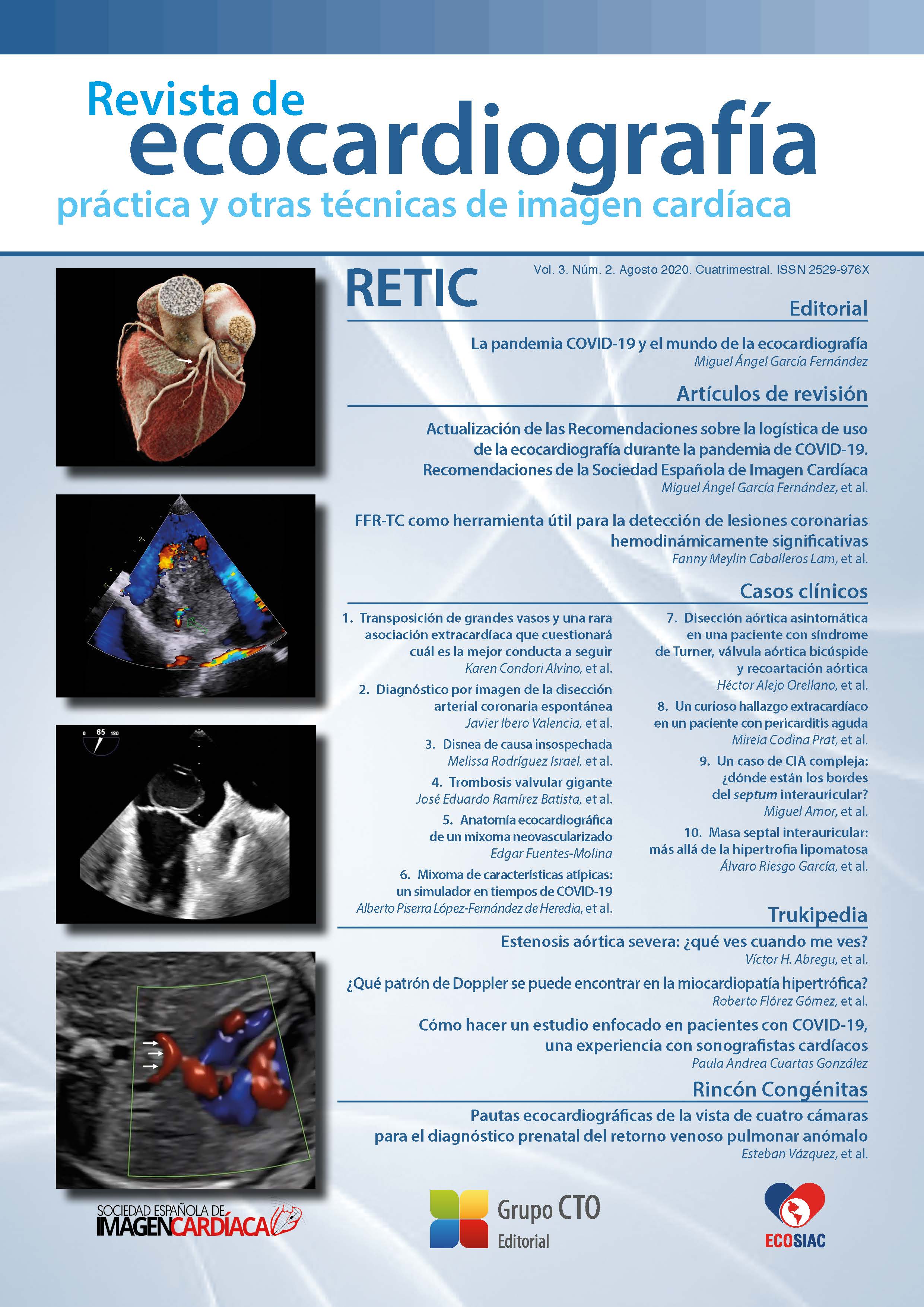FFR-TC como herramienta útil para la detección de lesiones coronarias hemodinámicamente significativas
DOI:
https://doi.org/10.37615/retic.v3n2a3Palabras clave:
enfermedad arterial coronaria, coronariografía-TC, FFR-TC.Resumen
La coronariografía por tomografía computarizada (C-TC) es un método diagnóstico no invasivo para la valoración de enfermedad arterial coronaria. A pesar de su alta sensibilidad y valor predictivo negativo, su especificidad es baja, en especial para valorar la repercusión funcional de las lesiones obstructivas. El cálculo de la reserva fraccional de flujo mediante C-TC (FFR-TC) es un método innovador que permite, en un mismo estudio, la combinación de características anatómicas y hemodinámicas. Su uso en la práctica clínica habitual puede ser decisivo para orientar el manejo terapéutico, reducir la tasa de pruebas invasivas innecesarias y los costes en salud.
Descargas
Métricas
Citas
Chinnaiyan KM, Akasaka T, Amano T, et al. Rationale, design and goals of the Heart Flow assessing diagnostic value of non invasive FFRCT in Coronary Care (ADVANCE) registry. J Cardiovasc Comput Tomogr 2017; 11 (1): 62-67.
Tesche C, De Cecco CN, Albrecht MH, et al. Coronary CT angiography derived fractional flow reserve. Radiology 2017; 285 (1): 17-33.
Lim SH, Flammer AJ, Yoon MH, et al. The long-term effect of coronary stent on epicardial and microvascular endothelial function. Circ Cardiovasc Interv 2012; 5 (4): 523-529.
Mathew RC, Gottbrecht M, Salerno M. Computed tomography fractional flow reserve to guide coronary angiography and intervention. Intervent Car- diol Clin 2018; 7 (3): 345-354.
Zimmermann FM, Ferrara A, Johnson NP, et al. Deferral vs. performance of percutaneous coronary intervention of functionally non-significant coronary stenosis: 15-year follow-up of the DEFER trial. Eur Heart J 2015; 36 (45): 3182-3188.
Zarins CK, Taylor CA, Min JK. Computed fractional flow reserve (FFTCT) derived from coronary CT angiography. J Cardiovasc Transl Res 2013; 6 (5): 708-714.
Toth GG, Toth B, Johnson NP, et al. Revascularization decisions in patients with stable angina and intermediate lesions: results of the international survey on interventional strategy. Circ Cardiovasc Interv 2014; 7 (6): 751- 759.
Knuuti J, Wijns W, Saraste A, et al. 2019 ESC Guidelines for the diagnosis and management of chronic coronary syndromes. Eur Heart J 2020; 41 (3): 407- 477.
Knuuti J, Ballo H, Juarez-Orozco LE, et al. The performance of non invasive tests to rule-in and rule-out significant coronary artery stenosis in patients with stable angina: a meta-analysis focused on post-test disease probability. Eur Heart J 2018; 39 (35): 3322-3330.
Taylor CA, Fonte TA, Min JK. Computational fluid dynamics applied to cardiac computed tomography for noninvasive quantification of fractional flow reserve: scientific basis. J Am Coll Cardiol 2013; 61 (22): 2233-2241.
Ball C, Pontone G, Rabbat M. Fractional flow reserve derived from coronary computed tomography angiography datasets: the next frontier in non invasive assessment of coronary artery disease. Biomed Res Int 2018; 2018: 2680430.
Fairbairn TA, Nieman K, Akasaka T, et al. Real-world clinical utility and impact on clinical decision-making of coronary computed tomography angiography derived fractional flow reserve: lessons from the ADVANCE Registry. Eur Heart J 2018; 39 (41): 3701-3711.
Patel MR, Nørgaard BL, Fairbairn TA, et al. 1-Year impact on medical practice and clinical outcomes of FFRCT The ADVANCE Registry. JACC Cardiovasc Imaging 2020; 13 (1 Pt 1): 97-105.
Kueh SH, Mooney J, Ohanaet M, et al. Fractional flow reserve derived from coronary computed tomography angiography reclassification rate using value distal to lesion compared to lowest value. J Cardiovasc Comput Tomo- gr 2017; 11 (6): 462-467
Descargas
Publicado
Cómo citar
Número
Sección
Licencia
Derechos de autor 2020 Fanny Meylin Caballeros Lam, Elena Refoyo Salicio, Gorka Bastarrika Alemañ

Esta obra está bajo una licencia internacional Creative Commons Atribución-NoComercial-SinDerivadas 4.0.
RETIC se distribuye bajo la licencia Creative Commons Reconocimiento-NoComercial-SinDerivadas 4.0 Internacional (CC BY-NC-ND 4.0) https://creativecommons.org/licenses/by-nc-nd/4.0 que permite compartir, copiar y redistribuir el material en cualquier medio o formato, bajo los siguientes términos:
- Reconocimiento: debe otorgar el crédito correspondiente, proporcionar un enlace a la licencia e indicar si se realizaron cambios. Puede hacerlo de cualquier manera razonable, pero no de ninguna manera que sugiera que el licenciante lo respalda a usted o su uso.
- No comercial: no puede utilizar el material con fines comerciales.
- No Derivados: si remezcla, transforma o construye sobre el material, no puede distribuir el material modificado.
- Sin restricciones adicionales: no puede aplicar términos legales o medidas tecnológicas que restrinjan legalmente a otros de hacer cualquier cosa que permita la licencia.









